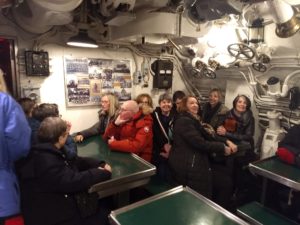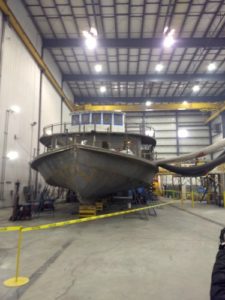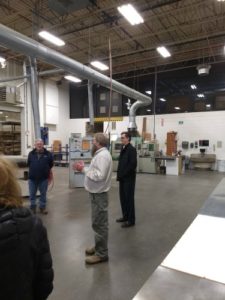
By Emily Clott, Class of 2012
Trapped at home as I am, riding out a worldwide pandemic, I enjoy recalling brighter days of travel. On February 25 (feels like 5 years ago), about 30 CAC staff, river docents, and river docents-in-training spent two days on a trip that culminated in a visit to the Emerald Lady, newest vessel in the First Lady fleet. The Agra family, CAC’s partners and owners of the Mercury and First Lady cruise lines, hosted the excursion.
Leaving Chicago on a Windy City Lines coach, we arrived just in time to enjoy a delicious lunch at Jack Pandl’s Whitefish Bay Inn, a venerable establishment operated by the same family and serving Wisconsin-classics for over 100 years.
Bellies full, we proceeded to the Pabst Mansion in downtown Milwaukee, a landmark that barely escaped the wrecking ball. One of several mansions in the heart of the beer capital’s downtown neighborhood, the area is reminiscent of the faded glory of Chicago’s Prairie Avenue district. The mansion, home of Captain Frederick Pabst, was one of a few dozen lavish estates that lined what was then Grand Avenue. Designed by George Bowman Ferry and Alfred Charles Clas, the construction lasted two years. It was completed in July, 1892, at a cost of more than $254,000, some $32 million in today’s money. The residence boasted 66 rooms and 14 fireplaces, and the complex included a carriage house, a pavilion, and a greenhouse.
Our docent engaged our attention with the story of Frederick Pabst who emigrated from Germany in 1848 at the age of 12. Eventually he became the captain of a steamer plying the waters of Lake Michigan between Chicago, Milwaukee, and Manitowoc. He married Maria Best in 1862 and bought a half interest in her father’s brewing company two years later. The Pabsts had ten children between 1863 and 1875, with five surviving to adulthood.
Upon Mr. Pabst’s death, each of his children was bequeathed a plot of land in the Grand Avenue district. None chose to live there but rather sold their properties to build in a more fashionable area on Lake Michigan’s shore. As the neighborhood lost its allure, most of the once elegant mansions met the wrecking ball. The Pabst Mansion, however, was purchased by the Catholic archdiocese of Milwaukee and served as the Church’s headquarters and the archbishop’s home until 1974, when it was threatened again with demolition.
A long battle to save the Pabst Mansion was won in the spring of 1978, but it took several years to transform the building into a viable house-museum. It was a 20,000 square-foot house of essentially empty rooms, many painted white, with wall-to-wall white carpeting. Fortunately, most of the mansion’s spectacular woodwork retained its 1892 finish, instilling a sense of hope for the home’s restoration. To the modern eye, the restored house is incredibly ornate, even fussy, in the Victorian style of the late 19th century. Dark fabrics and wall coverings abound. Still, the quality of the wood trim, the cabinetry, and chandeliers are undeniably evocative of how the wealthy lived in a long-gone era.
We left for Manitowoc in the late afternoon, and after a good night’s sleep headed to the Wisconsin Maritime Museum. The museum has grown into one of the largest maritime museums in the region since its founding in 1969. It commemorates the maritime heritage of the Manitowoc-Two Rivers area as well as the submarines built here during World War II.
The museum’s big attraction is the submarine USS Cobia. During World War II, the Manitowoc Shipbuilding Company built 28 submarines for the United States Navy. Though the USS Cobia was not one of them, for nearly 50 years she’s been a memorial to the men and women who built Manitowoc’s freshwater submarines and the sailors who served on them. By building submarines in a Lake Michigan port and transporting them through inland rivers, the Navy avoided the prying eyes of any spies who might be working along the East and West coasts.
When it was time to go on board, each of us CAC visitors had to ensure they could fit through a small hatch to enter interior spaces. Anyone with claustrophobia was discouraged from entering. Since that would be me, I stayed in the museum. Others will have to narrate the details of the visit inside the ship. By all accounts, it was fascinating.
A short coach ride deposited us at the Burger Boat Company, the culmination of our Wisconsin trek. We were guided through large industrial spaces where each step in the process of manufacturing the welded-steel Emerald Lady was explained. We entered a large hangar-like space where every river docent could easily recognize the incomplete, yet familiar, form of the newest boat in the river cruise fleet, the Emerald Lady. She was naked steel at this point, but the outline of her characteristic bow, captain’s house, deck, and downstairs salon were clearly discernible. Plans to christen her in late May were revealed. Who knew that Covid-19 might force her debut to be postponed?
The pilgrimage ended with boxed lunches on the bus as we headed down I-94. Thanks to the Agra family and CAC staff for their work hosting and planning this informative and enjoyable excursion! May we soon meet again at the dock for a summer season of smooth sailing!
CLICK HERE to see Dave Gudewicz’ photos of the Manitowoc trip.










Nice article on a fun trip. Thank you!
Lovely write up, Emily. It brought back many nice memories and hopes for a summer of boat rides — on the Emerald Lady or any of the boats. Thanks, Ellen
Now I’m even sorrier I couldn’t make this trip! Great story, Emily, thanks for sharing it with us.!
Great write up, Emily! Thanks for doing this and sharing our experience with the docent community!
I’m so grateful for the brilliant review of our fun and informative trip to Milwaukee and Manitowoc! Seeing The Emerald Lady under construction was so cool, but the Pabst Mansion and the Wisconsin Maritime Museum enriched us all.
Thanks for all your work, Emily, and a big “THANK YOU” also goes out to the Agra Family and CAC leadership!
Yep, seems like a long time ago given what we are facing today. Pray safety and good health to all!
Wayne
Great write up Emily. You are a great writer
Bob A